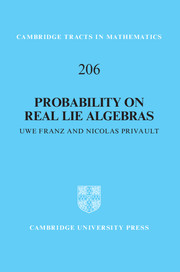Couples are wholes and not wholes, what agrees disagrees, the concordant is discordant. From all things one and from one all things.
(Heraclitus, On the Universe 59.)This chapter introduces the notion of joint (Wigner) density of random variables, for future use in quantum Malliavin calculus. For this we will rely on functional calculus on general Lie algebras, starting with the Heisenberg– Weyl algebra. We also consider some applications to quantum optics and timefrequency analysis.
Joint moments of noncommuting random variables
The notion of moment ⟨ϕ, Pnψ⟩ of order n of P in the state ⟨ϕ, ·ψ⟩ is well understood as the noncommutative analogue of E[Xn]. Indeed, in the single variable case, various functional calculi are available for elements of an algebra. In particular,
• polynomials can be applied to any element in an algebra;
• holomorphic functions can be applied to elements of a Banach algebra provided the function is holomorphic on a neighborhood of the spectrum of the element;
• continuous functions can be applied to normal elements of C*-algebras provided they are continuous on the spectrum of the element;
• measurable (i.e., Borel) functions can be applied to normal elements in a von Neumann algebra (e.g., B(h)), provided they are measurable on the spectrum of the operator.
In addition, the Borel functional calculus can be extended to unbounded normal operators (where normal means that XX∗ and X∗X have the same domain and coincide on this domain).
All the above functional calculi work due to a restriction to a commutative subalgebra. In that sense, Weyl calculus is fundamentally different because it applies to functions of noncommuting operators.
We now need to focus on the meaning of joint moments. For example, which is the noncommutative analogue of E[XY]? A possibility is to choose ⟨ϕ,PQψ⟩ as the the noncommutative analogue of E[XY], however this would lead to ⟨ϕ,QPψ⟩ as the the noncommutative analogue of E[YX] and we have E[XY] = E[YX] while
due to noncommutativity. A way to solve this contradiction can be to define the first joint moment as
Next, how can we define the analogue of E[XY2]? Proceeding similarly, a natural extension could be
Then what is the correct way to construct E[X2Y3]? Clearly there is a combinatorial pattern which should be made explicit.
